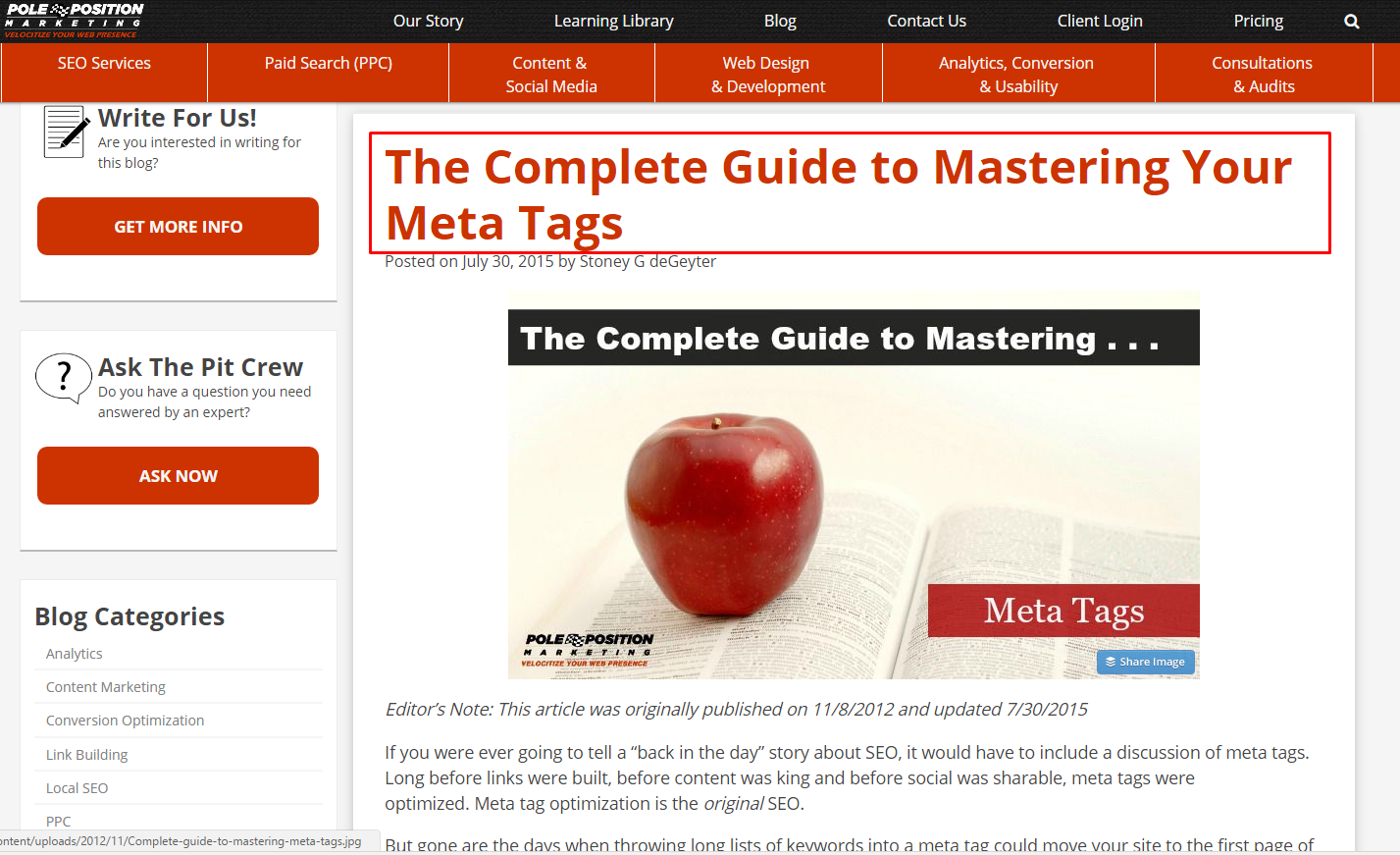Optimizing correctly can take days, months, even years. This is why optimizing quickly is so important. It gives you a jump out the gate while you do the ongoing, time-consuming work.
Don’t let perfection be the enemy of progress. SEO quickly first, then SEO correctly going forward.
Perfection is the enemy of progress.
–UnknownThey might have been talking about SEO.
As a perfectionist, I tend to get bogged down focusing on minor points. I’ll stress over little things often at the expense of the project as a whole.
I’m not suggesting that we shouldn’t always strive for perfection. But sometimes it’s better to do something quickly and come back to perfect it later. Pretty much the entire software industry has adopted that model. Create, test, launch, fix, improve.
And you know what? Many web marketing campaigns could stand to use a little of that model. It’s called going after the low-hanging fruit.
Here’s what you do in a nutshell: You find the biggest opportunities and/or the quickest fixes, and you tackle those first. Anything that’s going to take a while or not give you immediate gains gets put on the back burner. Not forever, but just until you get some wins.
SEO Quickly
There are a number of things you can do relatively quickly in SEO. Every site will be different, of course, but as a general rule, these are the first places I look.
Keyword Research
“Hold the phone!” you say. “Keyword research isn’t quick!” I sigh, walk over, and take the phone from you and say, “It can be if you don’t try to do it all at once.” (Sorry, that’s the aspiring novelist in me. 40,000 words written so far!)
Here’s the thing. Keyword research should be broken down into phases. For most sites there are just too many words and trying to dig them all out at once is more likely to bury you.
So start with the core topics/phrases. Pick out the unique ways people search for what you offer, minus all of the qualifiers.
Good: snow pants, winter jackets, mittens, snowmobile gear, etc.
No Good: fur hooded ski jacket, red parka jacket, waterproof long jacket, etc.It’s not that those keywords aren’t any good, it’s just they are for later, not for now.
For now, you want to keep it simple and find the unique phrases that will help you build out your site navigation.
Navigation
The next big win is to take your core term/topic phrases and figure out which ones are worthy of your primary navigation. You should have a list of mostly unique phrases, each deserving of its own landing page. Now is the time to plan that page!
Take for example a clothing store. Typical categories may be pants, tops, and dresses. But keyword research may reveal that searchers also seek clothing based on seasons, such as summer clothes, winter clothes, and evening wear. Or the research may show they like to shop by their favorite brand, as the store Forever 21 allows shoppers to do on their website.
You might find unique terminology that represents the exact same idea. Don’t create separate navigation pages for those. Determine which terminology is the most common and build the page for that. You can either work in the other terminology or save that phrase for a blog post down the road.
By focusing on your navigation early, you are priming your site to have a solid set of landing pages perfectly designed to give searchers exactly what they are looking for.
Architecture
Most website architecture issues won’t be quick. But some are.
What you need to do is to run your tools and separate out the tasks that can be done quickly, saving the others for later. Broken links are almost always a quick win, but there are others as well. Every site is different. What’s easy for one may be difficult for another.
The best way to do this is to create a master list of issues, and set a level of priority for each item on the list. That priority will be based on how much a fix will help you achieve optimization results. Send that to your developer and have him start with the highest priority items that are quick and work his way down to the intermediate level stuff. Then repeat the process.
This will get the quickest big wins off the table early on, which will keep you from getting bogged down in the big stuff that consumes a more significant portion of your resources.
Title Tags
Regardless if you have a site of ten pages or a hundred, customizing your title tags across the board is a nice boost for the more detailed optimization to come later. Not only can they give you a boost in the search rankings, they can also increase your click-through rate because it is the first thing searchers will see in the results for your listing.
You can optimize your title tags in two ways. One is to customize each one individually. The other is to create a schema in which to customize them dynamically. Most service-related sites would need hand customization while e-commerce sites can utilize the schema option.
Either way, the goal is to have every page of your site show a unique and compelling title tag that can help move the page up in search rankings while also compelling the searcher to click on the page.
Meta Description Tags
The same process applies to the meta description tags as the title tags. Description tags won’t help improve search rankings directly. However, they can have a significant impact on click-through rates because it is generally the text that appears below the title tag in search results:
If you can only have ranking improvements or better click-through rates, I’d choose click-through rates!
Heading Tags
The first job of a page heading — especially the one at the top of the page — is to let the visitor know what page they landed on. The top heading should confirm they are either on the correct — or incorrect — page. If the page is not going to meet their needs, no reason to keep them hanging around.
But if they are on the right page, they need to know it. And scanning the page, the rest of the headings should reinforce the main heading.
But that’s not the only role of a heading tag. The second role, which can be equally important, is to keep the reader engaged with the content. That means that it must compel (that word again!) them to keep reading.
Really, this is Marketing 101. Don’t “SEO” your headings. Make them something worthy of being read and that makes searchers stick around to stay engaged with your website.
SEO Correctly
Once you’ve done the quick work of SEO, you can dive into a more detailed optimization process. What that process looks like is up to you, but there are plenty of resources that will help you along.
If you made any mistakes in the “quickly” portion, no worries. This is where you’ll fix them. But chances are, anything will be minor, and what you do going forward is just in addition to the work already performed.
Optimizing correctly can take days, months, even years. This is why optimizing quickly is so important. It gives you a jump out the gate while you do the ongoing, time-consuming work.
Don’t let perfection be the enemy of progress. SEO quickly first, then SEO correctly going forward.
Source: SEO Quickly — Then SEO Correctly | Search Engine Journal
502.822.6695
team@guardianowldigital.com







Recent Comments